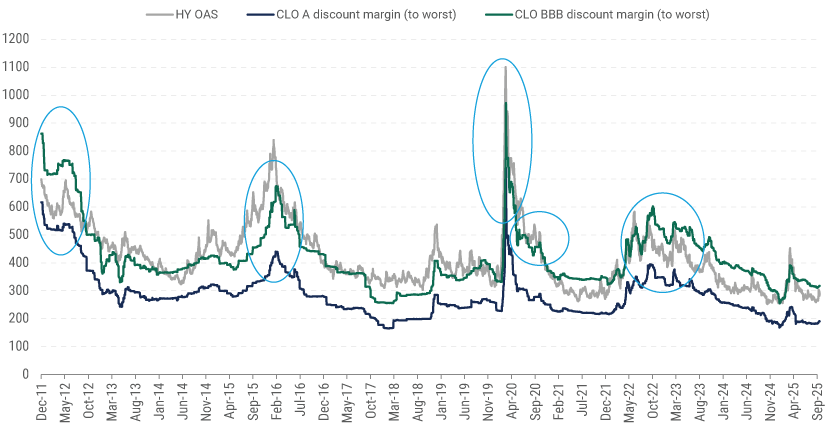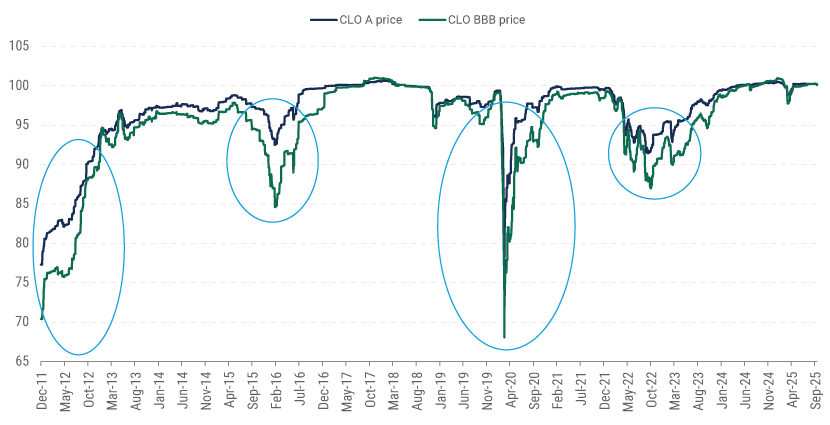Today’s Sweet Spots in CLO Tranches

Laila Kollmorgen, CFA
Global Head of CLO Tranche Investments, Portfolio Manager

Komal Shahzad, CFA
CLO Tranche Analyst

Jonathan Kramer, CFA
Fixed Income Product Specialist, Leveraged Finance
Looking at historical collateralized loan obligation (CLO) spreads, we believe the sweet spots for opportunistic investment in single-A and BBB tranches are 300 bps and 450 bps, respectively.
When spreads widened in April of this year, they still fell short of truly opportunistic levels, in our view, and single-A and BBB tranches are trading at par or even a slight premium to par.
We prefer to see entry points at discounted dollar prices, offering attractive convexity. As such, we’d favor buying single-A and BBB CLOs in the secondary market at a price discount of five to 10 points.
Junior BBB tranches have appeared more frequently in CLOs issued over the past two years to provide some par subordination enhancement to the regular (senior) BBBs. For these investment-grade junior tranches, our analysis suggests spreads would need to widen to 600 to 700 bps to provide an opportunistic entry level.

With valuations fair to rich on assets across the risk spectrum, investors are looking for attractive opportunities – and some are asking about the most compelling entry points for CLOs. To answer this question, we gathered historical spread data for single-A and BBB rated CLO tranches, highlighting periods when markets sold off and spreads for these tranches blew out to over 300 basis points (bps) and 450 bps, respectively (see chart).
We saw these levels as recently as the fourth quarter of 2023 and consider them attractive for investing opportunistically in single-A and BBB rated CLO tranches. For market context, we assessed high yield (HY) spreads as well to better illustrate the broader credit spread widening that should typically accompany such a buying opportunity within CLOs.
Market Sell-offs Have Created Periods of Attractive CLO Spreads

Source: JP Morgan and Bloomberg as of 16 October 2025.
When CLO spreads widened in April of this year, they still fell short of truly opportunistic levels, in our view. We were just starting to see spreads become attractive for certain profiles, but the opportunity was short-lived, and markets quickly retraced the widening. In addition to spreads being more fairly valued, we are also currently seeing single-A and BBB tranches trading at par or even at a slight premium to par (see chart).
For an opportunistic investment, we prefer to see entry points at discounted dollar prices, offering attractive convexity. As such, we’d favor buying single-A and BBB CLOs in the secondary market at a price discount of five to 10 points.
Single-A and BBB Rated CLO Tranches Are Trading At or Just Above Par

Source: JP Morgan as of 16 October 2025.
Lastly, it’s important to highlight the emergence of the junior BBB tranche, which we’ve seen more frequently in CLOs issued over the past one to two years. These junior BBB tranches – a response to possible higher NAIC capital charges on tranches rated BBB- and below – are subordinate to regular/senior BBBs and are, typically, very thin tranches representing only about 1% of the deal size. The primary purpose of these senior/junior BBB structures is to provide some par subordination enhancement to the regular (senior) BBBs without having to issue a large BB tranche, given that the BB cost of liability is much higher than that of BBBs.
Since junior BBBs are still investment grade, there is a non-insurance buyer base that finds them attractive, especially for the spread pickup they provide versus the senior BBBs, which is anywhere from 100 to 200 basis points depending on the credit curve. However, we don’t have historical spread and performance data for these junior BBBs going back to the post-crisis period. Therefore, we can only estimate how wide junior BBB spreads could go. However, our analysis suggests spreads would need to widen to 600 to 700 bps to provide an opportunistic entry level.
Headwinds meet tailwinds
While CLO spreads remain on the tight end of historical averages, there is a case to be made that tight valuations are warranted given an accommodative fundamental backdrop of low but positive growth, combined with tailwinds from both monetary stimulus and upcoming stimulative fiscal policy via tax cuts. That said, roller-coaster trade dynamics and other currents will keep markets fluid, and we expect to see both positive shocks, in the form of deal announcements or teases, and negative ones, such as more aggressive policies or deal disappointments.
Despite likely headline-driven volatility in the coming months, we believe the risk is balanced. Nonetheless, tight valuations tilt incrementally toward a more defensive portfolio bias. We believe having a nimble approach is paramount given the pace of news flow, which is rapidly shifting consumer and business sentiment. In addition, a robust bottom-up approach to security selection remains key given significant tail risks to the fundamental backdrop along with a market bifurcated between vintages and, relatedly, between deals that are in and out of their reinvestment periods.
Given the dispersion in the loan market, certain CLO portfolios holding weaker credits may eventually experience impairments to the lowest-rated debt tranches – something that has begun to play out following the recent and fast-moving bankruptcy filing of an aftermarket automotive parts supplier, which could result in attractive opportunities to move down the capital stack.
Ultimately, vintage, portfolio, and manager selection remain key.
Disclosure
Investing involves risk, including possible loss of principal. The information presented herein is for illustrative purposes only and should not be considered reflective of any particular security, strategy, or investment product. It represents a general assessment of the markets at a specific time and is not a guarantee of future performance results or market movement. This material does not constitute investment, financial, legal, tax, or other advice; investment research or a product of any research department; an offer to sell, or the solicitation of an offer to purchase any security or interest in a fund; or a recommendation for any investment product or strategy. PineBridge Investments is not soliciting or recommending any action based on information in this document. Any opinions, projections, or forward-looking statements expressed herein are solely those of the author, may differ from the views or opinions expressed by other areas of PineBridge Investments, and are only for general informational purposes as of the date indicated. Views may be based on third-party data that has not been independently verified. PineBridge Investments does not approve of or endorse any republication of this material. You are solely responsible for deciding whether any investment product or strategy is appropriate for you based upon your investment goals, financial situation and tolerance for risk.



